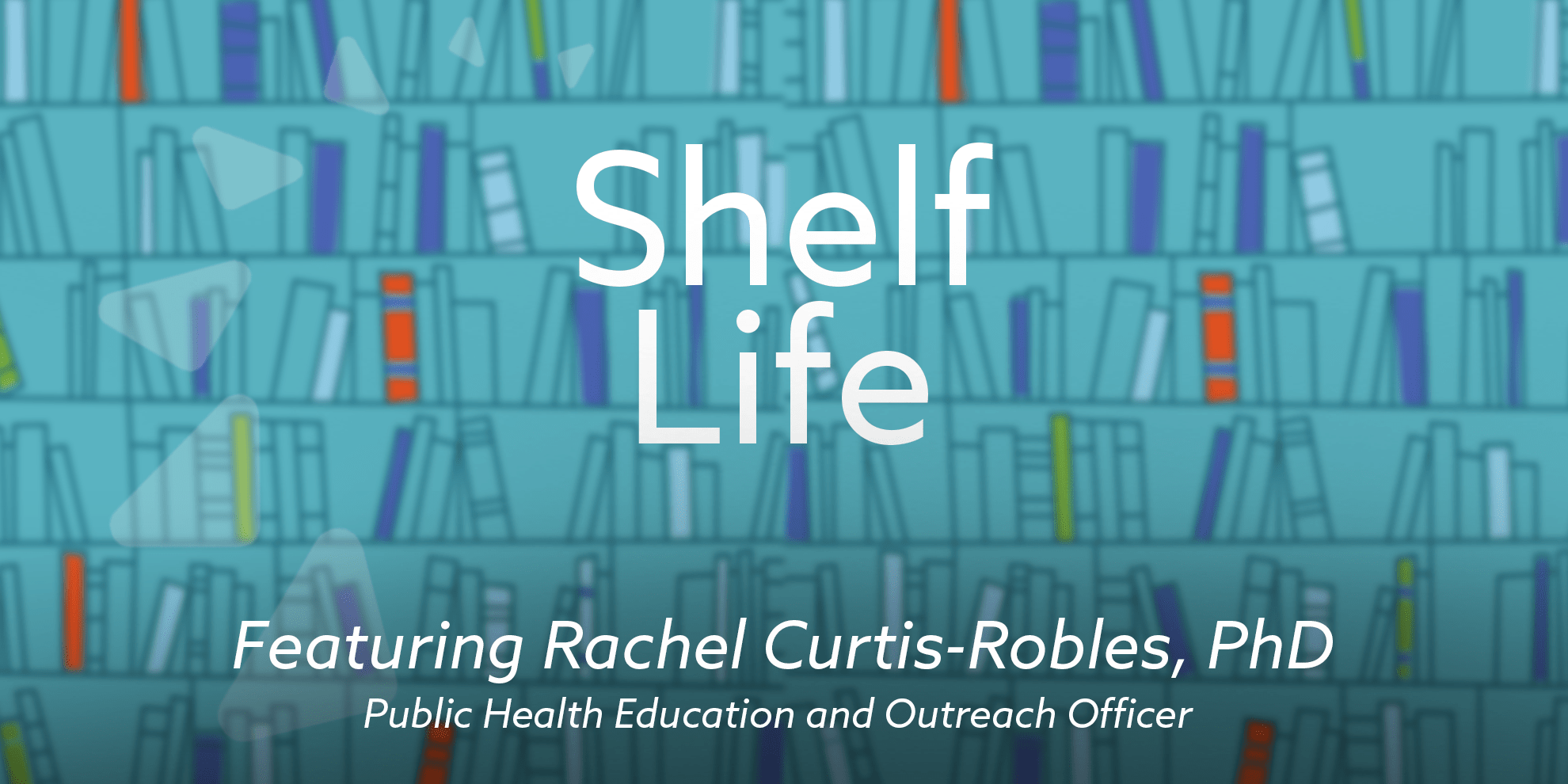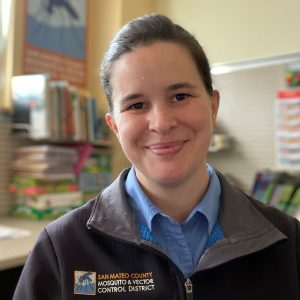 Rachel Curtis-Robles (she/her) is an ecologist and infectious disease epidemiologist. She joined the San Mateo County Mosquito and Vector Control District in January 2021 as the Public Health Education and Outreach Officer. Her role includes presenting to community groups, managing the District’s brand and image, and educating residents about the no-charge services the District offers to everyone living in San Mateo County. By far, her favorite part of her work is visiting school classrooms to teach children about the mosquito life cycle and support a hands-on and fun science learning environment.
Rachel Curtis-Robles (she/her) is an ecologist and infectious disease epidemiologist. She joined the San Mateo County Mosquito and Vector Control District in January 2021 as the Public Health Education and Outreach Officer. Her role includes presenting to community groups, managing the District’s brand and image, and educating residents about the no-charge services the District offers to everyone living in San Mateo County. By far, her favorite part of her work is visiting school classrooms to teach children about the mosquito life cycle and support a hands-on and fun science learning environment.
The District is a taxpayer-funded independent special district that is responsible for all mosquito control in the County. The District also provides no-cost elimination of yellowjacket nests, customized reports/tips to help keep homes free of rats and mice, tick-borne disease surveillance, insect identification and a variety of other vector-related services.
We asked Rachel what she's reading and some of the books that have made the biggest impact in her life. Read on for her responses.
What are you currently reading?
I read a book called Mosquito to classes at least five times a week. This book was created by a partnership between the Lee County Mosquito Control District (in Florida) and the Puerto Rico Vector Control Unit. This book is a core part of our District’s outreach program, and I use it to start every classroom visit, from preschool up through high school.
The author/illustrator team created some adorable illustrations to accompany a scientifically accurate story telling the mosquito life cycle. The illustrations are engaging enough for the preschools I visit, and I adjust my reading according to the grade level of the class I’m visiting. It’s always neat to see what details the children notice in the book – there is a smiling emoji-style cloud toward the end of the story that is always a big hit!
What did you read as a child?
Every book I could get my hands on! Children’s literature has always been my favorite genre. Perhaps this is a side effect of my mother being an elementary school teacher or being the oldest sibling. We had weekly library trips in the summers, and she finally had to restrict the number of books we could take home each week. Otherwise, we’d happily sit dawn till dusk reading, ignoring the sun outside, our chores and even meals. The 20-book-a-week limit felt hugely restricting at the time; of course, now as a parent, I understand that playing outdoors, learning household responsibilities and eating are all important as well.
What's the last book you read that made you laugh?
Two books about insects (of course!) gave me some surprising laughs in the past few months.
La metamorphosis de Frufrú is a delightful story (in Spanish) about a larva that is first distraught and then elated at the thought that she will metamorphosize into a butterfly. But, if you pay attention very carefully in the story, you can see that she is eating bits of a discarded sandwich, which…is not typically what a caterpillar eats. The last page is a great surprise about what she actually metamorphosizes into!
Another funny book is one that we checked out from the library in Spanish, La oruga muy impaciente (but is also available in English as The Very Impatient Caterpillar). This story will resonate with any child and adult familiar with how hard it is to WAIT for something exciting to happen. The caterpillar’s dialogue with another—presumedly wiser and more patient—caterpillar is hilarious. This one would be a great paired reading – either two adults reading the dialogue to a child, or a child reading the (fun) impatient caterpillar part and the parent reading the (boring) patient caterpillar part.
What book do you give as a gift?
Someone Builds the Dream is a marvelous book that came out just two years ago, and it’s a wonderful exploration and explanation of how critical builders are to our world. Not designers and engineers, but the people who actually build and make things. The incredible importance of informal education, vocational training and skilled trades tends to get lost in our society’s emphasize on the pursuit of formal education. Our society does not function without millions of people who work at building things every day. This book is a beautiful and humbling reminder to all of us!
We keep Someone Builds the Dream in our District’s lending library because our vector control technicians and vector ecologists sometimes do some messy, dirty jobs (we check sewer treatment plants for mosquito breeding, we crawl around under houses to check for rats, we come back from the marshes and creeks covered in mud some days). The training to become a certified technician is on-the-job, intense and messy, and while we’re not building something physical, we are "building" an environment with fewer mosquitoes and vectors so that our communities are healthier.
Books you recommend?
When I first started in this position, I read hundreds of children’s books about insects, looking for ones that were scientifically accurate, but also age-appropriate and stimulating for children. My daughter and a co-worker’s children played a big role in this! (Shout out to Penelope, Leo, Cecilia, Adelaide, and Bosco!) They were reading loads of books we took home and checked out from the library.
Eventually, we curated a set of books that met all the criteria, and we now have a "lending library" at the District. When I visit classrooms, I take a set of 15-25 books that stay in the classroom for a few weeks so the students can learn more about mosquitoes, about general insect ecology, about diversity and inclusion in science, and other important topics. Here are some of the books.
- The Bug Girl is a marvelous book about a REAL fourth grade girl who really liked looking at bugs but was bullied by her peers.
- How to Build an Insect has great illustrations and walks through all the parts that make an insect.
- Summer Birds is the story of 13-year-old Maria Merian, who went against the beliefs of her time (that all insects were evil and that they came from the mud) and made incredible illustrations of insects while discovering how caterpillars metamorphosize into butterflies.
- Buzzing with Questions is an inspiring book about Charles Henry Turner, an African American scientist who studied how ants solve problems and discovered that bees see color.
- Evelyn the Adventurous Entomologist is the story of Evelyn Chessman, who lived about 100 years ago, loved taking care of animals and became the first woman in charge of the London Zoo’s insect house. She traveled the world to explore and collect insects.
- Heads and Tails Insects is one of my favorite books for lower elementary students. The book gives three clues and a partial picture for you to guess what insect is on the next page.
- 13 Ways to Eat a Fly is a super fun book with fun illustrations about all the ways insects are part of the food web.
- Crawly School for Bugs is a collection of really funny short poems (perfect for ‘just one more’ before bedtime) about insects. Of course, my favorite one is about the "school nurse" that is a mosquito and "needs a blood sample" regardless of what ailment the insect students come to her office with. My other absolute favorite in this book is “Cricket Lessons: How to be Annoying in 4 Easy Steps.”
- Hey, Little Ant is written in rhyme and a catchy way to get kids (and adults!) to think about how to put themselves in others’ shoes. It mentions peer pressure and how your decisions affect others.
- Spring After Spring tells the story of Rachel Carson – the scientist who wrote Silent Spring and critically changed society’s understanding of our connection to the Earth. The book includes aspects of her whole life, from childhood to adulthood, with illustrations appropriate for young readers.
- Karl, Get Out of the Garden! tells the story of the life of Carolus (Karl) Linneaus, starting from when he was a child who loved to be outside looking at things. As an adult, he invented the naming conventions that all scientists now use to name living things.
- On Beyond Bugs is a fun rhyming book with the Cat in the Hat that shares interesting things about all sorts of bugs.
- Fly Guy Presents: Insects uses the ever-popular Fly Guy to share fun facts about insects.
- Greg’s Microscope follows a young boy as he gets and learns how to use a microscope. This was a book I remember reading as a child – there are some nice illustrations of how different things look under a microscope.
- What Bug am I? follows a bug as she tries to discover what type of bug she is. She meets many other kinds of bugs along the way, and compares and contrasts herself with others to find out where she fits.
What do you plan to read next?
My next read will probably be the Mosquito book, in a classroom somewhere in San Mateo County! Teachers can learn more about our programming and sign up for a presentation on our website.
I am also on the hunt for a great children’s book about marshes. Marshes are a critical ecosystem for us to protect, especially in the face of sea level rise. Marshes support a diversity of organisms, including…mosquitoes! Our District originally started (over 100 years ago) with work to create fewer opportunities for mosquitoes to grow in stagnant water in the marshes. Our work in the marshes continues today, with our staff visiting marshes all around the County on a regular basis to control mosquitoes. In the summer, we work with biologists from the California State Coastal Conservancy to control an invasive cordgrass that outcompetes the native cordgrass and threatens the marshes. We are also in regular communication with federal and state biologists about the status of endangered and threatened species living in the marshes where we work. While many people might think of marshes as kind of muddy places with funky smells, they are a critical and valuable ecosystem. If anyone knows of a great book about marshes, please let me know!
Shelf Life is an occasional series of San Mateo County Libraries, where we talk to the San Mateo County community about books books books! Inspiration taken from book pages everywhere, including The Guardian and the New York Times.



Add a comment to: Shelf Life: Rachel Curtis-Robles